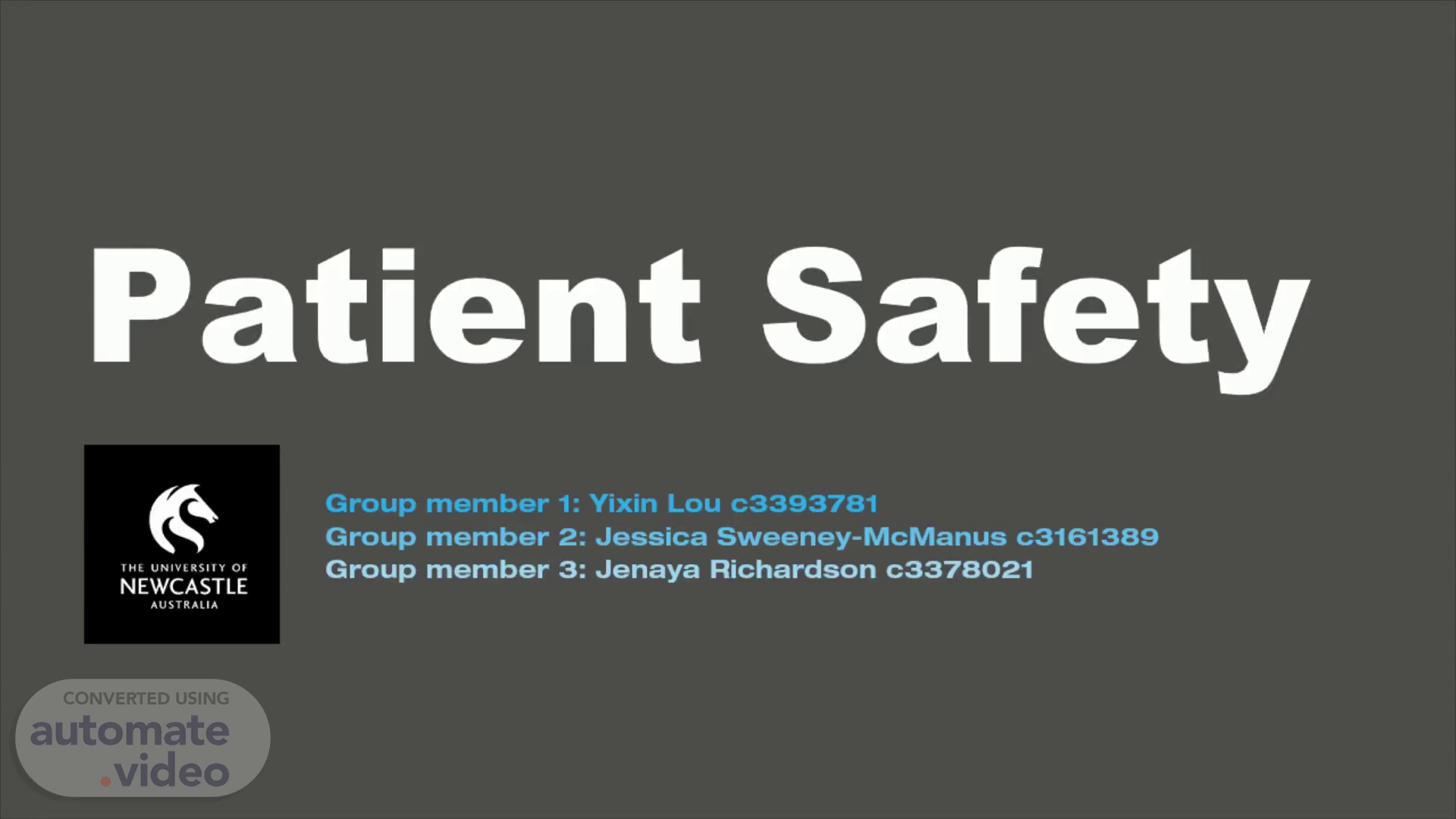
Page 1 (0s)
Patient Safety. . Group member 1: Yixin Lou c3393781.
Page 2 (11s)
GROUP QUESTION. Define the term ‘safe nursing practice and identify your responsibilities as a professional Registered Nurse in relation to patient safety. Safe Nursing practice can be defined as a nurses responsibility to prevent any avoidable harm from occurring to patients and working to ensure patient safety. Any decisions made by registered nurses may affect the potential health outcomes of patients. Therefore, nurses have the responsibility to always provide a safe environment for their patients. One way this can be achieved is through safe medication administration, reducing the risk of medication errors (Lee & Wessol, 2022). All nurses have the responsibility to reduce risks to patient safety throughout the healthcare process (Safe practice: Nursing Roles and Assignments, 2020). Professional registered nurses have a duty of care to consider all factors that may impact patient safety including falls risks, medication administration and safety of a night. Registered nurses have the responsibility to apply organisational policies and procedures as guided by the National Safety and Quality Health Service Standards (Australian Commission on Safety and Quality in Healthcare, 2017). These standards provide consistent statements of care to improve areas of quality and safety for patients..
Page 3 (58s)
QUESTION 1. . Group member 2 : Jessica Sweeney-McManus c3161389.
Page 4 (1m 56s)
QUESTION 2. Group member 3: Jenaya Richardson c3378021.
Page 5 (3m 46s)
QUESTION 4. I n question 4, the first safety measure leaving the bathroom light on can be an appropriate one. But it might not be suitable for hospitalised older people with a walking frame. Because it can negatively increase the risk of falls on the patient's way from bed to the bathroom. The second safety measure withholding the diuretic medication can be violated person-centred care in nursing, due to the patient needing this drug to remove excess water and salt in the body. Also, many medications have been related to falls, especially for those older adults with disability. (Gross, A., Elliott, D. P., Lasky, T., Samanta, D., Kafka, W., Murphy, M., & Patel, A. 2021) F urthermore, for an older patient in this case with a walking frame, keeping the side rails up can only help this lady move around the bed. So, is not help much for the trip that going to the bathroom. Therefore, providing this lady with a bedside commode can be the most appropriate safety measure according to the patient's conditions in this case. Because this is the easiest way for patients with a disability who need frequently to go to the toilet, and this lady doesn’t even need her walking frame during the nighttime. It can decrease the potential fall risk for the patient. Therefore, raising nurses’ understanding of fall risks can effectively increase patients' safety in Australia. (YASAN, C., BURTON, T., & TRACEY, M. 2020. ).
Page 6 (5m 30s)
REFERENCE LIST. ACSQHC (Australian Commission on Safety and Quality in Health Care) (2005). Preventing Falls and Harm From Falls in Older People — Best Practice Guidelines for Australian Hospitals and Residential Aged Care Facilities 2005, Australian Government, Canberra P 47 & 57. https://www.safetyandquality.gov.au/sites/default/files/migrated/Guidelines-HOSP.pdf Barry, E., Galvin, R., Keogh, C., Horgan, F., & Fahey, T. (2014). Is the timed up and go test a useful predictor of risk of falls in community dwelling older adults: a systematic review and meta-analysis. BMI Geriatrics 14. https://doi.org/10.1186/1471-2318-14-14 Browne, C., Kingston, C., & Keane, C. (2014). Falls prevention focused medication review by a pharmacist in an acute hospital: implications for future practice. Int J Clin Pharm, 36 (5), 969-975. doi: 10.1007/s11096-014-9980-3 Canzan, F., Mezzalira, E., Solato, G., Mortari, L., Brugnoli , A., Saiani, L., Debiasi, M., & Ambrosi, E. (2021). Nurses' Views on the Use of Physical Restraints in Intensive Care: A Qualitative Study. International journal of environmental research and public health, 18(18), 9646. https://doi.org/10.3390/ijerph18189646 Gross, A., Elliott, D. P., Lasky, T., Samanta, D., Kafka, W., Murphy, M., & Patel, A. (2021). Change in Medication-Associated Fall Risk Among Older Adults After Admission for Fall-Related Trauma. Journal of Trauma Nursing, 28(6), 363–366. https://doiorg.ezproxy.newcastle.edu.au/10.1097/jtn.0000000000000615.
Page 7 (6m 36s)
REFERENCE LIST. Lee, K. C. C., & Wessol, J. L. (2022). Clinical Reasoning, Judgment, and Safe Medication Administration Practices in Senior Nursing Students. Nurse Educator, 47(1), 51–55. https://doi-org.ezproxy.newcastle.edu.au/10.1097/NNE.0000000000001059 Marques, P., Queirós, C., Apóstolo, J., & Cardoso, D. (2015). Effectiveness of the use of bedrails in preventing falls amongst hospitalised older adults: a systematic review protocol. JBI Database of Systematic Reviews & Implementation reports, 13 (6), 4-15. https://doi:10.11124/jbisrir-2015-2116 Safe Practice: Nursing Roles and Assignments. (2020). Missouri State Board of Nursing Newsletter, 22(2), 4. Tzeng, H. M., Yin, C. Y., Anderson, A., & Prakash, A. (2012). Nursing staff's awareness of keeping beds in the lowest position to prevent falls and fall injuries in an adult acute surgical inpatient care setting. Medsurg nursing : official journal of the Academy of Medical-Surgical Nurses , 21 (5), 271–274. Yasan, C., Burton, T., & Tracey, M. (2020). Nurses’ documentation of falls prevention in a patient centred care plan in a medical ward. Australian Journal of Advanced Nursing, 37(2), 19–24. https://doi-org.ezproxy.newcastle.edu.au/10.37464/2020.372.103.